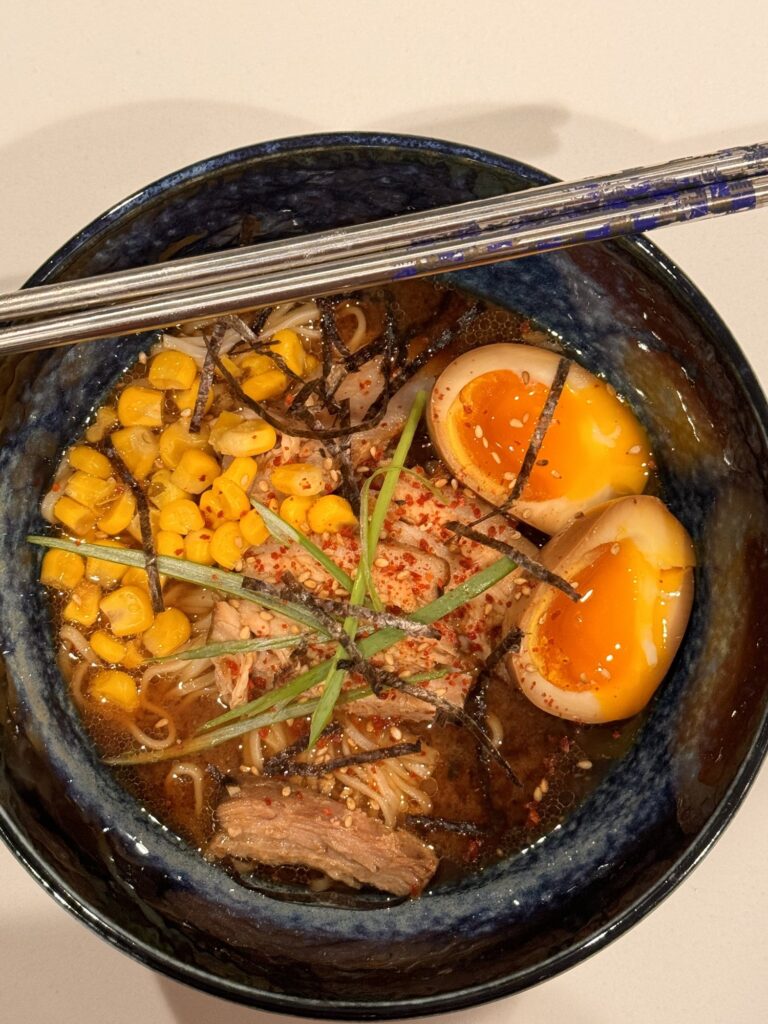I think it’s safe to say, ramen is addicting. Who doesn’t love slurping the delicious and comforting umami flavor and chewy noodles served in warm soothing broth? Also, it’s pretty cheap and kind of reminds us of our college days cramming for exams and eating Cup ‘O Ramen into the late night.
In the last few years, ramen has become quite popular, with many ramen restaurants popping up as well as a variety of different flavors of packaged ramen. While Japanese-style ramen restaurants did exist in the US before the ramen boom of the 21st century, they primarily catered to the needs of the Japanese people who lived in and worked in the area.
It wasn’t until the spread of Japanese pop culture showing anime such as “Naruto” slurping their favorite bowls of steaming hot ramen. This was shortly followed by the opening of David Chang’s Momufuku Noodle Bar in New York City in 2004. Since then, the ramen boom has continued to gain momentum.
But where exactly did ramen come from? Who made the first bowl of ramen? As it turns out, just like any other food, ramen has a deep history rooted in you guessed it, rationing food and making the most of what people had at the time.
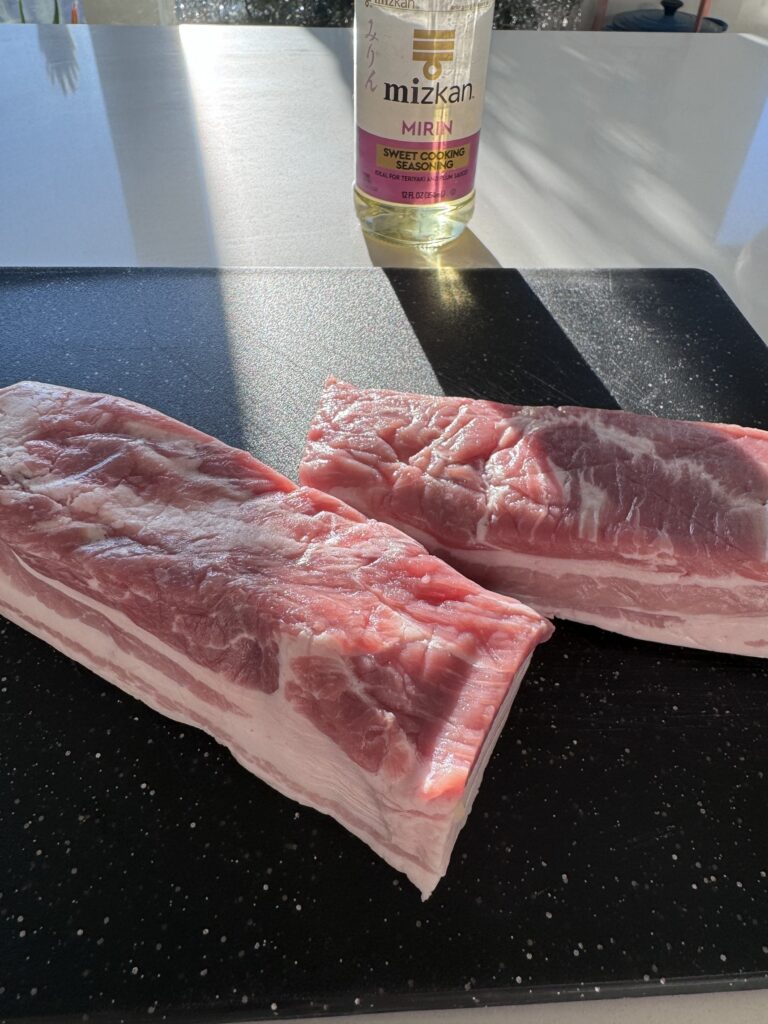
THE HISTORY OF RAMEN
While most associate ramen with Japanse origin, ramen actually originated in China in the 1800s. From there, Chinese immigrants traveled to Japan in the late 19th or early 20th century after the Meiji Restoration in 1868. It was then that the first ramen shop opened in Tokyo in 1910. Rairaiken served up bowls of ramen as a fusion of Chinese noodles and Japanese cuisine.
The Japanese cut the noodles instead of pulling them by hand as the Chinese did. The word “ramen” is a variation of the Mandarin term for “pulled noodles.” Another theory proposes that the word derives from laomian, or “lo mein.” which in Cantonese means to “stir,” and the name refers to the method of preparation by stirring the noodles with a sauce.
In 1947, Fukuoka, the now famous Hakata tonkotsu Ramen was born by chef overboiled the soup, making the pork broth extra milky and white. Regional variations started to pop up with the first being Ajino Sanpei in Sappora. Hokkaido was the first ramen bar to create miso ramen, now synonmous with Hokkaido.
After WWII ended, the US occupied and economically devastated Japan and purposely saturated the food market with wheat to compensate and control the shortage of rice. Outdoor stalls started serving ramen noodles, offering workers a quick hot meal at all hours of the day and night.
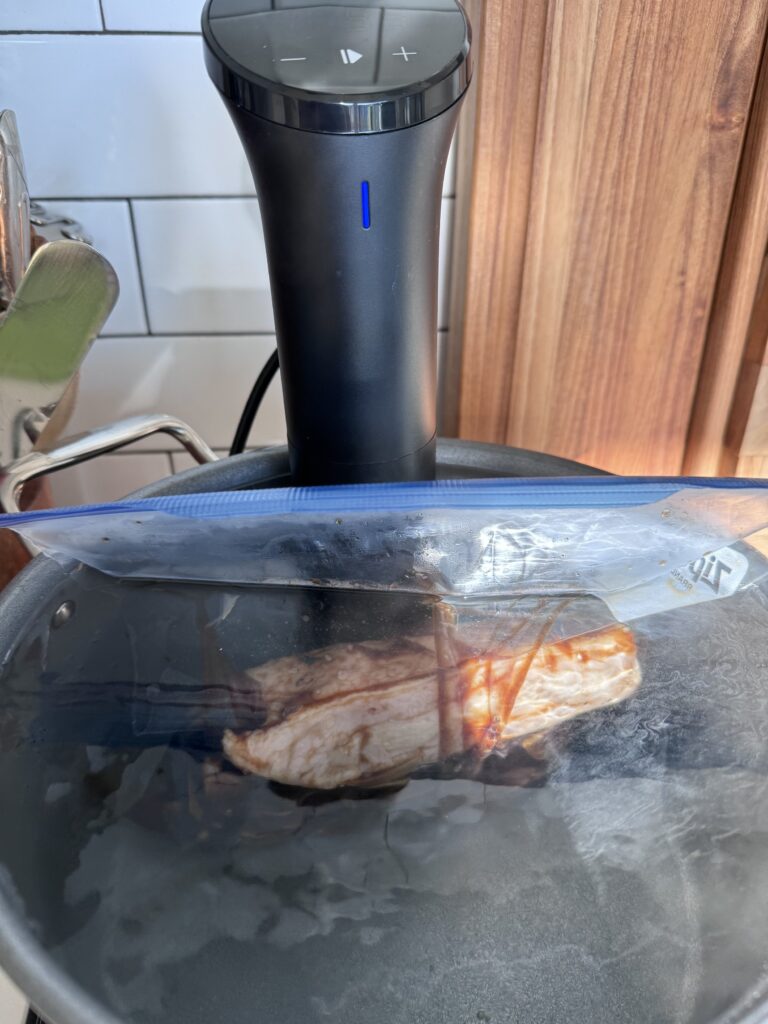
THE INVENTION OF RAMEN
A Taiwanese-Japanese man named Momofuku Ando spent years watching his community struggle with hunger. He spent months experimenting with how to flash-fry wheat noodles in a la he built. He discovered that boiling fried, dried noodles would rehydrate them, and adding seasoning powder and dehydrated toppings made for a delicous and quick meal.
He began marketing his instant ramen noodles in August of 1958, choosing chicken as the first flavor, which very easily was able to be marketed in America. When he bought instant ramen to the States, he sold the noodles in a Styrofoam bowl, theorizing that not many Americans would have bowls on hand.
Ando created Nissin Foods, who created Cup Noodles, and it quickly became popular after it’s debut in 1973. Today, the company makes other instant ramen brands such as Top Ramen and Maruchan.
TYPES OF RAMEN
There are four different types of ramen, usually characterized by seasoning.
Shio (meaning salt), is the oldest variation and is typically pale and yellowish. It is derived from the original Chinese-style noodle soups. This type of ramen is most popular in Hakodate, a southern city in the Hokkaido area where strong Chinese ties influence local cuisine.
Shoyu, or soy sauce, is a saltier popular ramen and is most popular in the Kanto region of Central Japan. The broth is traditionally clear to brown, and the flavor is usually chicken, seafood, and sometimes pork or beef-based. Also, it is common to see tonkotsu pork broth flavored with shoyu.
Miso gained popularity in the mid-1960s. It originated in Northern Hokkaido, where cold weather demanded a bolder, heartier bowl of soup. Today, it is usually topped with sweet corn or stir-fried pork belly and bean sprouts.
Kare is the latest type to emerge, which is very similar to a curry soup and is made of pork bones and vegetables.
RAMEN TOPPING
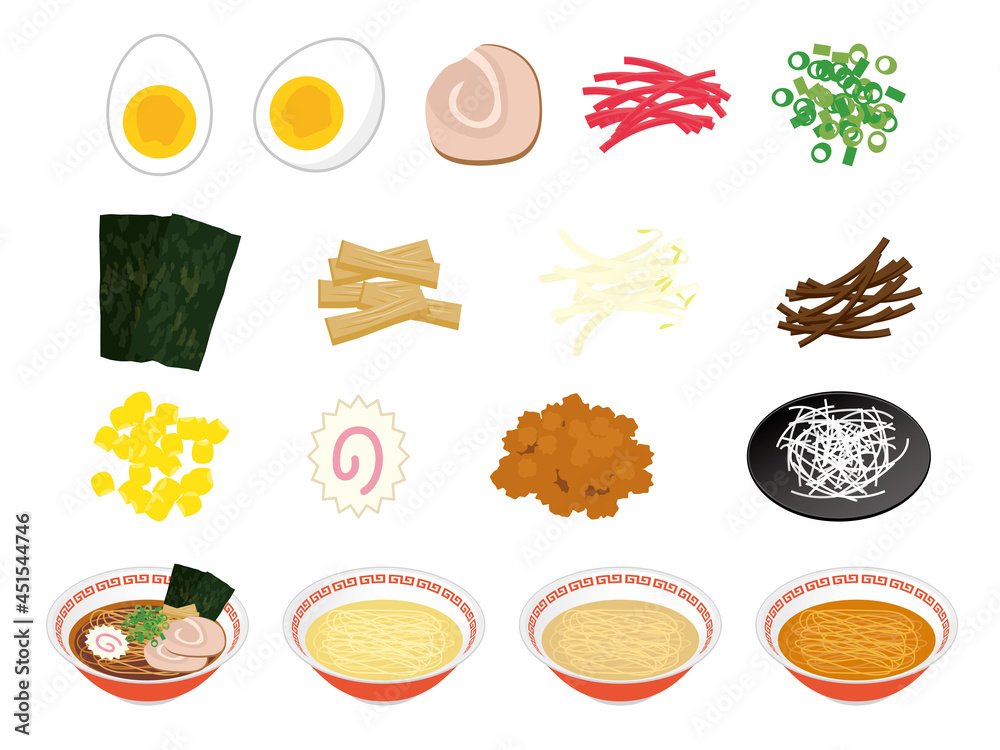
Protein
The most popular protein topping is Chashu pork. It is similar to Chinese char siu roast pork. The Japanese version is made by simmering pork in a sweet soy sauce and mirin sauce until it’s tender.
Kakuni is similar to chashu but these comes in chunks of meat. Bacon is also another topping, which is usually sliced and added to the simmering broth, or stir-fried before adding to the bowl.
Shredded pork has become more popular due to David Chang using it at Momofuku. Ground meat is also another topping and is stir-fried with bean sprouts or cabbage.
Seafood such as shrimp or scallops can also be added and pairs great wtih lighter seafood broth.
Kamaboko is a white and red fish that is sliced and is placed on top.
Eggs
By far, my favorite topping is a soft-boiled or poached egg. Ajitsuke tamago is a soft-boiled egg that has been marinated in soy sauce for several hours. Onsen tamago is soft-cooked eggs and is usually sous vide around 140°F to 145°F. What you will get is a perfect custardy and runny egg.
Vegetables
Scallions are a must-have to top off any bowl of ramen. Corn has gained popularity and is mostly served in miso-based ramen. Cabbage is often added and can be fresh or stir-fried.
Enoki mushrooms are added raw but will soften and cook a bit in the hot broth, adding an earthy flavor. Fresh garlic can also be added to enhance the broth’s flavor.
Preserved Vegetables
Kimchi is a popular addition and adds a kick to any bowl of ramen, especially when you add the juice. Nori can also be added to top off, adding a crunchiness with each bite. Wakame is a type of seaweed and is usually found in shio ramen, adding an ocean-like taste.
Pickled ginger or Beni shoga pairs great with tonkotsu broth.
Condiments and Spices
Togarashi is a popular Japanese chili powder and is sprinkled on top of ramen bowls.
Sansho pepper is the Japanese version of the Sichuan peppercorns from China and adds extra heat to any bowls.
Yuzukosho is a spice paste made with salted chile peppers and the rind of the yuzu, a Japanese fruit. It’s usually added to the broth while cooking.
Sesame seed pairs great with miso-flavored ramen.
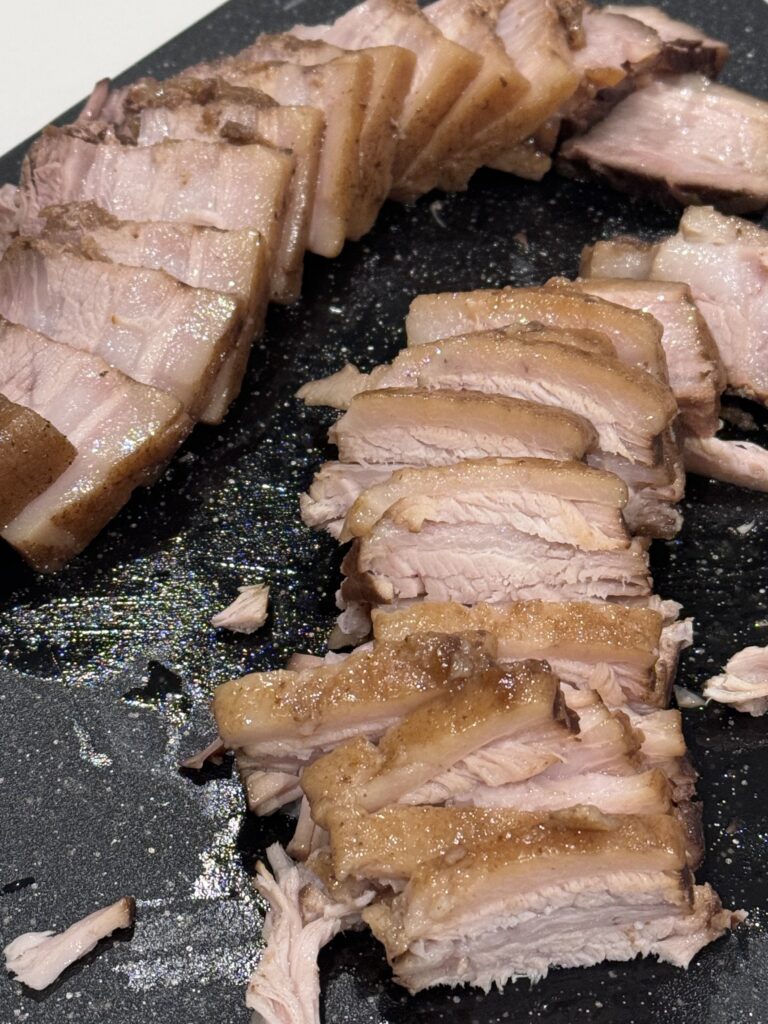
The Recipe
WHAT YOU WILL NEED:
Pork Belly
- 1/4 cup mirin (Japanese sweet cooking wine)
- 2-inch piece fresh ginger, thinly sliced (about 1/4 cup)
- 2 cloves garlic, thinly sliced
- 2 green onions, white parts only (reserve the green parts for garnish), cut into 1-inch lenghts
- 1/4 cup soy sauce
- 1 pound pork belly, in a single piece, skin removed
Broth
- 4 cups homemade pork stock or store-bought low-sodium chicken broth
- 1/4 cup white or red miso, or a mixture of both, plus more to taste if needed
- 1/2 teaspoon freshly ground white pepper
- 1/2 teaspoon toasted sesame oil
- 4 servings ramen noodles (8 ounces dried or 12 ounces fresh)
- 1 cup bean sprouts
- 2 sheets toasted nori, each torn into 4 pieces (8 pieces total)
- 4 large eggs, cooked sous vide
- 2 tablespoons toasted sesame seed, for garnish
- 2 green onions, green part only, thinly sliced, for garnish
- 1 tablespoon Japanese togarashi or other red pepper flakes, for garnish
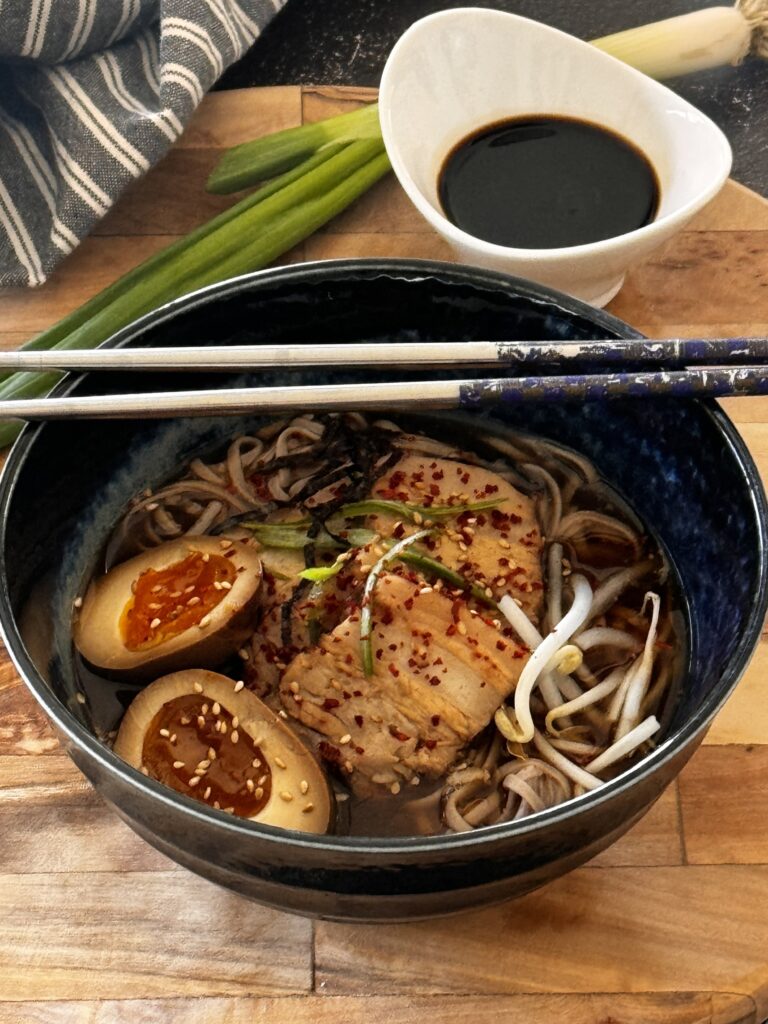
Step 1:
Preheat your sous vide water bath to 170.6°F.
To prepare the pork belly, combine the mirin, ginger, garlic, and green onions (white parts only) in a small saucepan over medium-high heat and bring to a boil.
Step 2:
Remove from heat and add soy sauce. Place the pork belly in a gallon-size ziplock bag, pour in the mirin mixture, and then seal using the water displacement method.
Step 3:
When the water reaches the target temperature, lower the bagged pork belly into the water bath, making sure the bag is fully submerged, and cook for 12 hours. Make sure to check the bag every few hours to ensure the bag is fully submerged. Also, to minimize evaporation, cover the bath with plastic wrap or foil.
Step 4:
Remove the bag from the water and let the pork belly rest for about 10 minutes. Transfer the pork to a cutting board and set aside.
Pour the accumulated cooking juices through a fine-mesh sieve into a liquid measureing cup or bowl and discard the ginger, garlic, and green onions. Skim the fat off if desired.
Step 5:
To make the broth for the ramen, pour the cooking juices into a large saucepan, add the stock, miso, white pepper, and sesame oil, and bring to a rolling boil over medium-high heat.
Turn down the heat to medium and continue to cook at a lively simmer (you should be able to see bubbles), whisking until the broth is opaque and completely smooth (no lumps of miso) and slightly reduced, 8-10 minutes.
Step 6:
Taste the broth. It should be very robust and salty; whisk in more miso if you think the broth needs more oomph.
Cover the pan and lower the heat to keep the broth warm until ready to serve.
Step 7:
Cut the pork belly against the grain into 1/4-inch thick pieces. When you’re ready to serve, cook the ramen noodles in boiling water according to the package instructions, drain, and then divide evenly among four warmed deep soup bowls.
If the broth has cooled off, bring it to a simmer again and ladle it into the bowls. Divide the sliced pork belly, bean sprouts, and nori between the bowls. Top each bowl with an egg, and then sprinkle with sesame seeds, reserved green onions, and togarashi.
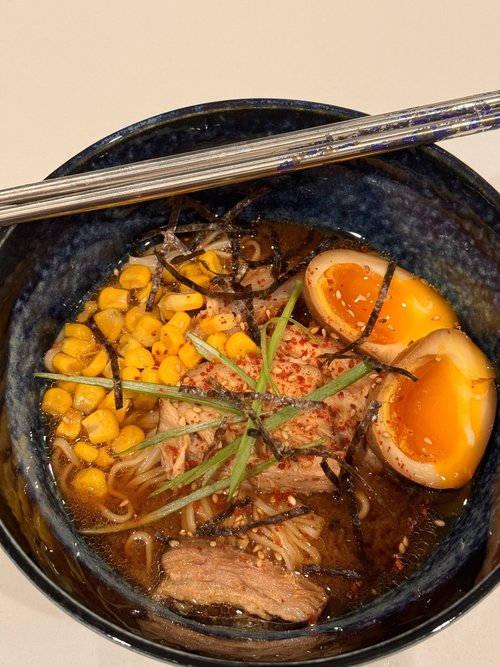
Sous Vide Pork Ramen
Ingredients
Broth
4 cups homemade pork stock or store-bought low-sodium chicken broth
1/4 cup white or red miso, or a mixture of both, plus more to taste if needed
1/2 teaspoon freshly ground white pepper
1/2 teaspoon toasted sesame oil
4 servings ramen noodles (8 ounces dried or 12 ounces fresh)
1 cup bean sprouts
2 sheets toasted nori, each torn into 4 pieces (8 pieces total)
4 large eggs, cooked sous vide
2 tablespoons toasted sesame seed, for garnish
2 green onions, green part only, thinly sliced, for garnish
1 tablespoon Japanese togarashi or other red pepper flakes, for garnish
Pork Belly
1/4 cup mirin (Japanese sweet cooking wine)
2-inch piece fresh ginger, thinly sliced (about 1/4 cup)
2 cloves garlic, thinly sliced
2 green onions, white parts only (reserve the green parts for garnish), cut into 1-inch lenghts
1/4 cup soy sauce
1 pound pork belly, in a single piece, skin removed
Instructions
Sous Vide Broth
Preheat your sous vide water bath to 170.6°F.
To prepare the pork belly, combine the mirin, ginger, garlic, and green onions (white parts only) in small saucepan over medium-high heat and bring to a boil.
Remove from heat and add soy sauce. Place the pork belly in a gallon-size ziplock bag, pour in the mirin mixture, and then seal using the water displacement method.
When the water reaches the target temperature, lower the bagged pork belly into the water bath, making sure the bag is fully submerged and cook for 12 hours. Make sure to check the bag every few hours to ensure the bag is fully submerged. Also, to minimize evaporation, cover the bath with plastic wrap or foil.
Remove the bag from the water and let the pork belly rest for about 10 minutes. Transfer the pork to a cutting board and set aside.
Pour the accumulated cooking juices through a fine-mesh sieve into a liquid measuring cup or bowl and discard the ginger, garlic, and green onions. Skim the fat off if desired.
To make the broth for the ramen, pour the cooking juices into a large saucepan, add the stock, miso, white pepper, and sesame oil, and bring to a rolling boil over medium-high heat.
Turn down the heat to medium and continue to cook at a lively simmer (you should be able to see bubbles), whisking until the broth is opaque and completely smooth (no lumps of miso) and slightly reduced, 8-10 minutes.
Taste the broth. It should be very robust and salty; whisk in more miso if you think the broth needs more oomph.
Cover the pan and lower the heat to keep the broth warm until you’re ready to serve.
Cut the pork belly against the grain into 1/4-inch thick pieces. When you’re ready to serve, cook the ramen noodles in boiling water according to the package instructions, drain, and then divide evenly among four warmed deep soup bowls.
If the broth has cooled off, bring it to a simmer again and then ladle it into the bowls. Divide the sliced pork belly, bean sprouts, and nori between the bowls. Top each bowl with an egg, and then sprinkle with sesame seeds, reserved green onions, and togarashi.
Recommended Products
Nutrition Facts
Calories
643.59
Fat
50.59 g
Sat. Fat
18.37 g
Carbs
28.71 g
Fiber
2.13 g
Net carbs
26.56 g
Sugar
4.32 g
Protein
19.93 g
Sodium
1342.96 mg
Cholesterol
178.43 mg


